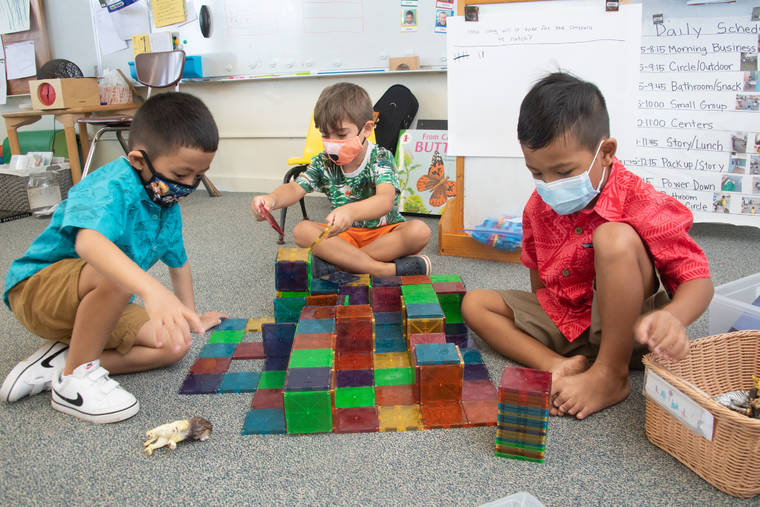Hawaii’s children under economic stress, national report finds

CRAIG T. KOJIMA / APRIL 23
Children created a maze during pre-kindergarten class at Keolu Elementary School.
The well-being of Hawaii’s children was declining especially on the economic front even before the pandemic, according to the 2021 Kids Count Data Book released today.
Hawaii ranked 26th overall in children’s well being among the 50 states, but in the economic category it fell to 44th in the national report published by the Baltimore-based Annie E. Casey Foundation. The data book assesses how children are faring on 16 indicators of health, economics, education and family/community.
“It is very concerning that Hawaii already ranked in the bottom 10 states on children’s economic well-being, according to these pre-pandemic data,” said Ivette Rodriguez Stern, junior specialist at the University of Hawaii Center on the Family. “It took the lowest-income families a decade to recover from the Great Recession, and now we are once again facing the threat of a greater share of our keiki growing up in economic hardship, which can have long-lasting effects on education and future employment.”
The best states for children were Massachusetts, New Hampshire and Minnesota, which placed first, second and third in the Kids Count rankings. The worst were Lousiana, New Mexico and Mississippi, at 48th, 49th and 50th place. Child welfare tends to correlate with household income.
The 2021 Data Opens in a new tabBook Opens in a new tab relies on the latest state-by-state and national information, which largely is from 2019. But the foundation that issued the report said that the coronavirus pandemic in 2020 hit children especially hard, so indicators have likely only worsened since then.
The federal government has set up a website Opens in a new tab to spread the word to families about a new tax credit of $250 to $300 per child per month that should start flowing with payments that start next month. The credit is for 2021 but the foundation and President Joe Biden want to extend it into future years.
Don't miss out on what's happening!
Stay in touch with breaking news, as it happens, conveniently in your email inbox. It's FREE!
“The COVID-19 crisis has brought many families to the breaking point, especially parents and caregivers who have lost jobs and income,” said Lisa Hamilton, president and CEO of the Annie E. Casey Foundation. “Making the expanded child tax credit permanent will continue providing critical financial support for families who are struggling to make ends meet and help reduce long-standing disparities that affect millions of families of color.”
The economic measures in the Kids Count Data Book include poverty, housing costs, parental unemployment and idleness among teens. The report pegged Hawaii’s child poverty rate at 12%, well below the national average of 17%. But the figures don’t take into account Hawaii’s high cost of living.
The economic indicator that showed the most substantial change, year over year, in Hawaii was the fraction of teens not in school and not working. That rate of idle teenagers rose from 6% in the 2020 Data Book to 10% in the current one, while the national rate remained at 6%.
And that was before the switch to online education last March, which resulted in more students not attending even virtual school, as Hawaii’s unemployment rate soared with pandemic restrictions.
Another troubling indicator in the report that showed substantial change was the death rate for kids. There were 24 deaths from all causes per 100,000 for children aged 1 to 19 in the state in 2019, a big jump from 19 the previous year. Nationally the rate was 25 per 100,000.
Housing costs also rose with 38% of Hawaii’s keiki in households with a high housing cost burden, the second-worst rate in the nation after California. The U.S. rate overall was 30%.
“By revealing that Hawaii’s keiki were falling behind the rest of the nation even before the pandemic, the newest KIDS COUNT Data Book should be a warning bell to everyone who cares about our state’s children,” said Deborah Zysman, executive director of Hawaii Children’s Action Network. “Policymakers and community leaders must act boldly to prevent our children’s well-being from deteriorating further.”
On the plus side, the teen birth rate, which has dropped dramatically in the last decade, continued to fall. There were 16 births per 1,000 teens in Hawaii, down from 17 in the previous year. In 2010, the figure was 33. The national rate shows the same trend, dropping to 17 teen births per 100,000, compared to 34 in 2010.
Kids Count
>>The 2021 Kids Count Data Book is available online at aecf.org Opens in a new tab.
>>Details on the newly expanded federal Child Tax Credit are available at whitehouse.gov/child-tax-credit/ Opens in a new tab.



